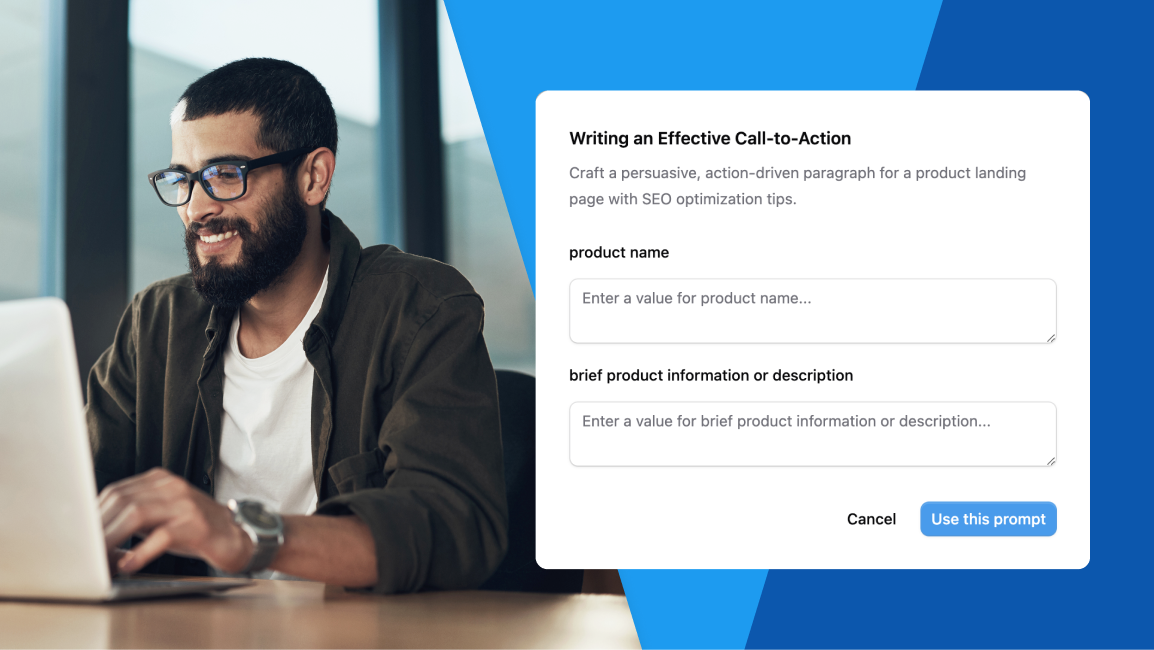With an AI chatbot, you can enhance numerous aspects of your everyday marketing work, including saving time on repetitive tasks, generating creative ideas, and developing a deeper understanding of your audience.
If you’ve experimented with an AI chatbot, you may have noticed that the more powerful the input, the more beneficial the output. Valuable AI usage starts with learning how to create prompts or finding effective prebuilt options. This list contains a few examples of AI prompts that help you work smarter.

3 sample prompts for marketing
Generative AI helps marketers accomplish numerous tasks across all areas of their strategy, from researching the target audience and industry to generating outlines and content ideas. Use these examples to get started with AI or expand your horizons.
1. SEO and keyword optimization
Search engine optimization (SEO) is a vital part of marketing, especially in the digital world. It allows you to raise your rankings in search engines so customers can find you online. Part of the SEO process involves identifying keyword opportunities related to your topic and target audience.
Here’s a prompt to generate keyword ideas:
Task: Generate a list of keyword ideas for a given topic and target audience. Definitions: – Keywords: Specific words or phrases that capture the main themes or concepts of a topic. They are often used in content creation and SEO to help target relevant audiences. Directions: 1. Analyze the given topic to identify the main themes, concepts, and related subtopics. 2. Consider the target audience and what types of keywords they might use when searching for information on the topic. 3. Brainstorm a list of potential keywords, including main keywords, long-tail keywords, and keyword variations. 4. Refine the list by selecting the most relevant and effective keywords for the topic and target audience. 5. Organize the final list of number keywords in a clear and concise format.
User Inputs: topic {{topic}} – audience {{audience}}
This prompt combines multiple lengthy steps involved in keyword research into one. Beyond finding a list of keywords, you will learn more about your topic and audience. These details enable you to employ keywords more knowledgeably in your content.
Change the topic and audience variables for each new project to harness the same prompt repeatedly.
2. Customer and audience analysis
Who’s buying your product or service, and how can you effectively market to them? Customer and audience analysis allows you to answer these questions. Once you know about your audience, you can more effectively target and personalize marketing messages to create a better customer experience.
Research your target audience with the following prompt:
Task: Create a comprehensive ideal customer profile to effectively identify and target the right audience for a product or service. Definitions: – Demographic information: Statistical data about a population, such as age, gender, income, education level, and occupation. – Psychographic characteristics: Psychological attributes, including personality traits, values, attitudes, interests, and lifestyles. – Purchase behavior: The decision processes and actions involved in buying and using goods and services. Directions: 1. Identify the product or service for which the ideal customer profile is being created. 2. Determine the target age range, gender, income level, education, and occupation of the ideal customer. 3. Describe the ideal customer’s personality traits, values, attitudes, interests, and lifestyle that align with the product or service. 4. Analyze the ideal customer’s purchase behavior, including their motivation for buying, preferred channels, and decision-making process. 5. Summarize the demographic information, psychographic characteristics, and purchase behavior into a concise ideal customer profile. 6. Use this profile to guide marketing strategies, product development, and customer service to effectively reach and engage the target audience.
User Inputs: {{product or service}}
With this prompt, you will gain a comprehensive understanding of your marketing message’s target audience, from their age to their interests. You will even learn how they make purchasing decisions and gain ideas for your marketing strategy.
If you offer multiple products or services, you can create a unique customer profile for each, enabling more personalized marketing efforts.
3. Content marketing and strategy
As a marketer, you plan and develop numerous types of content, from blog post articles to videos. This content engages customers and leads them to interact with your company and buy your product or service.
Often, the most challenging part of content marketing is deciding where to start. A prompt gives you the building blocks that serve as the foundation for your content strategy. For example, enter these instructions to develop a blog outline:
Task: Create a detailed blog outline on the topic with H2, H3, subheadings, and bullet points. Definitions: – H2: Top-level headings in the outline that represent main sections – H3: Second-level subheadings within each H2 section – Subheadings: Additional subheadings within H3 sections to further break down the content – Bullet points: Key points, examples, or supporting information under each subheading Directions: 1. Identify the main sections of the blog post and list them as H2 headings 2. Break down each H2 section into smaller, more specific H3 subheadings 3. If needed, add additional subheadings under H3 to provide more granular organization 4. Under each subheading, include bullet points for key information, examples, or supporting details 5. Ensure the outline flows logically and covers all important aspects of the topic.
User Inputs: {{topic}}
All you need to do is replace the variable at the end with a topic. An AI chatbot will use this prompt to develop a detailed outline with all the essential information you should cover.
Once you have this outline, add and remove information to suit your business. Reduce the time spent outlining so you can dedicate more effort to developing quality content and performing other marketing tasks.
Enhance your work with TeamAI Prompt Libraries
TeamAI is a generative AI platform with specialized features built for business use. It includes a built-in library with all the above prompts and many others.
Prompts are organized into folders by team and type of task, so you can quickly find the one you need. Experiment and find the most effective ones for your work.
When you use TeamAI for business, you can also create and share custom prompts with other team members. Tailor them to suit your particular requirements and then share them with others so your whole team benefits.
Discover Custom Prompt Libraries
Get started Today

Try the examples in this list or hundreds more in TeamAI. Create a workspace to explore our expansive Custom Prompt Library, plus other features like chat sharing and organization through Collaborative Workspaces.
